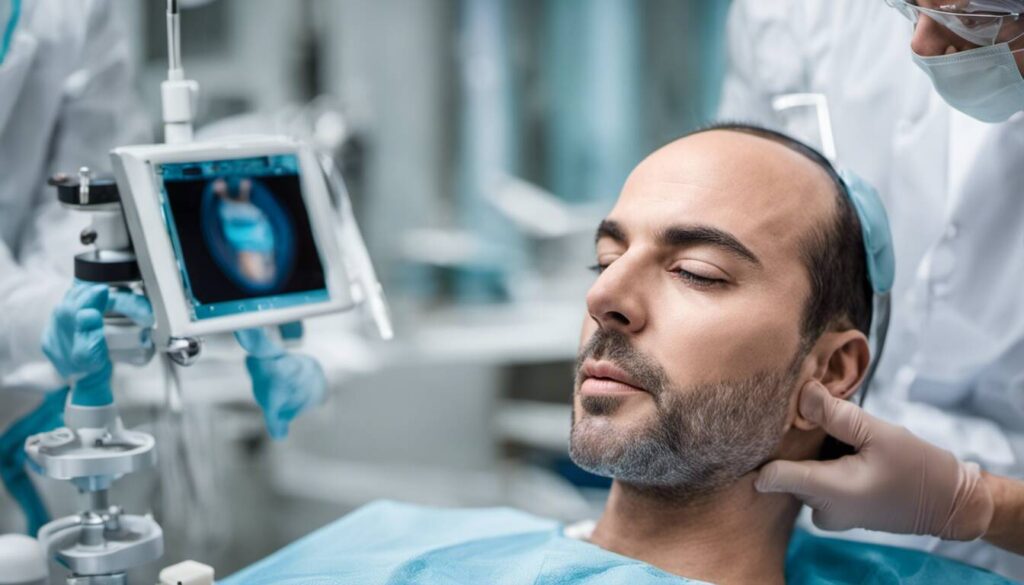Hair transplant surgery is becoming more common these days with improved technology and natural results. Hair transplant surgery has evolved and is no longer obvious, making men more interested. Men and women no longer need to settle for going bald or losing their hair. Hair restoration options today are natural-looking, and recovery is minimal.
In recent years, hair transplant surgery has gained significant popularity as a solution for individuals struggling with hair loss. The prevalence of hair transplant surgery is a testament to the increasing number of people seeking this procedure to restore their confidence and regain a fuller head of hair.

NeoGraft is Becoming More Popular
NeoGraft is the only FDA-approved follicular unit harvesting and implantation system. NeoGraft is automated FUE (follicular unit extraction), which means this device delivers automation of the FUE technique. NeoGraft uses a vacuum-like suction to extract the grafts from the back of the scalp and implant the hair follicles to the thinning or balding areas, which is more efficient than any other FUE technique. With NeoGraft the grafts have a 98% survival rate, which increases the success of the grafting process.
With this technique there is no cutting, which means no sutures or staples. Downtime is extremely minimal and most normal activity can be resumed the day after surgery. FUE is ideal for individuals who prefer to wear their hair short and do not want a visible scar.
The Strip Technique for Hair Transplant Surgery
The ‘strip method’ or FUT (follicular unit transplant) is a bit more invasive than the FUE technique because it involves removing a piece of the scalp that contains a dense strip of hair from the back of the head. The hair that is extracted from areas like the back of the scalp or sides of the head are more resistant to balding, which makes hair transplant surgery long lasting.
The strip method does require sutures and minimal downtime. After approximately a week of care to the incision, the sutures are removed and normal activity with minimal restrictions can be resumed the day after surgery. This method is better for those who wear their hair a little longer in the back and the scar essentially heals great and is unseen.
Undetectable Hair Replacement
In the past hair transplant surgery was very obvious and even looked fake. There were large gaps, and the angle of the grafts were too straight. Today, Drs. Thompson and Henstrom are able to achieve natural outcomes by dissecting the harvested hair (follicular units) into very small sections, making each graft look like it belongs exactly where it’s being placed. Both of our expert surgeons also have extensive experience with hair restoration techniques and attention to detail which is necessary when artistically placing the grafts.
Hair Restoration Options
For individuals in the beginning stages of hair loss but especially following a hair transplant, it is important to hang on to the hair they have and prevent as much future hair loss as possible. Which is why we recommend that most patients consider other methods of hair restoration such as hair loss medication (Propecia), vitamins, Rogaine or non-surgical hair restoration treatments. With consistent use of the products your surgeon recommends will help preserve the hair you have while also promoting thicker, healthier hair.
Career and Social Impacts after Surgery
Hair transplant surgery can have a significant impact on both your career and social life. For many individuals, hair loss can affect their self-confidence and how they perceive themselves in professional and social settings. By restoring a natural-looking hairline and fuller head of hair, hair transplant surgery can help boost self-esteem and improve one’s overall appearance.
Consider a professional who has suffered from hair loss for years and feels conscious about their thinning hairline during meetings or presentations. After undergoing a successful hair transplant procedure, their newfound confidence might lead to improved performance in their career. They may find themselves better able to engage with colleagues and clients, making a positive impression that could potentially open up new opportunities.
Beyond the workplace, the social impacts of hair transplant surgery can also be significant. Many individuals feel more comfortable and confident engaging in social activities after the surgery, whether it’s attending parties or going on dates. Hair restoration can contribute to an enhanced sense of self-worth and allow individuals to participate fully in various aspects of their personal lives.
It’s important to note that while hair transplant surgery can have positive effects on career and social aspects, it is crucial to manage expectations realistically. Each person’s experience may vary, and other factors such as overall appearance, personality, and interpersonal skills also play significant roles.
Related Resources
- The Cost of Hair Transplant Surgery at Utah Facial Plastics
- Pros and Cons of an Overseas Hair Transplant
- When Is The Right Time To Have Hair Transplant Surgery?
- How Successful Is Hair Transplant Surgery?
- Can You Wear a Hat After a Hair Transplant?
For more information about hair transplant surgery please contact UFP Hair Restoration at our Draper or Layton, Utah office at (801)849-8149.